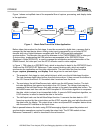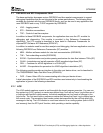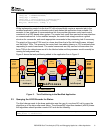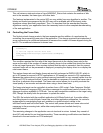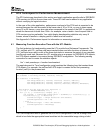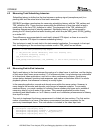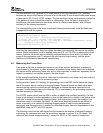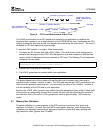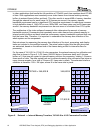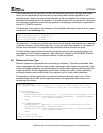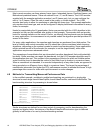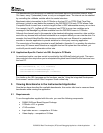
SPRAA56
12 DSP/BIOS Real-Time Analysis (RTA) and Debugging Applied to a Video Application
4.2 Measuring Task Scheduling Latencies
Scheduling latency is defined as the time between a wakeup signal (semaphore post) to a
pending task and the actual start of that task's execution.
DSP/BIOS provides a mechanism for measuring scheduling latency with the TSK_settime and
TSK_deltatime APIs. These functions accumulate the difference in time from when a task is
made ready to the time TSK_deltatime is called. The placement of the TSK_deltatime API
therefore determines what is actually measured. Scheduling latency can be measured by
placing the API directly after the task’s blocking call, which may be MBX_pend, SCOM_getMsg,
or a similar API.
Time differences are accumulated in each task's internal STS object, so there is no need to
create a separate STS object to measure scheduling latency.
This technique is used for each task in the instrumented application. For example, in the input
task, the beginning of the run-time loop contains a call to TSK_deltaTime as follows:
while(1) // Tsk main processing loop begins
{
/* TSK_deltatime called immediately after last blocking call,
to measure scheduling latency */
TSK_deltatime(TSK_self());
...
SCOM_getMsg(fromProctoInput, SYS_FOREVER); /* end of main processing loop */
...
}
4.3 Measuring End-to-End Latencies
End-to-end latency is the time between the capture of a video frame in real-time, and the display
of that same video frame some number (T) of milliseconds later. Long latencies are undesirable
in bi-directional video applications, such as in a video conferencing systems. Such latency
causes delays between questions and responses, and makes conversation difficult. In media
playback systems, the tolerance for latency is usually higher.
In the example application, encode and decode occur within the same system. However, in
many designs the encoder and decoder could be part of separate systems. To accurately
measure latency, you need a method of indicating frame numbers and types and a method of
measuring latency on both ends of the system. This example application provides frame
numbering and identification as I or P frames, as well as a rudimentary measurement of latency
from input to output.
The code to implement the latency measurement is divided into two sections. The first section
makes a timestamp for a frame if the latency measurement has been completed for the
previously timestamped frame. This code section is included in the video input task:
// measure input to output frame latency
if (benchCapVid.captodisplay.done) {
benchCapVid.captodisplay.frameNum = frameCaptureCnt;
benchCapVid.captodisplay.latency = CLK_getltime();
benchCapVid.captodisplay.done = 0;
}



